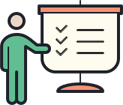Posted by Craig Mill on the 18th February, 2021

‘Creating Accessible Documents and Formats’ is a series of quick guides explaining how to create an accessible Word document and export it to a range of formats such as ePub, Large Print, PDF and more.
There are 11 videos in total which are organised in a contextual YouTube Playlist, starting with an introduction to creating accessible documents, to using a screen-reader and converting to PDF and alternative formats.
Creating accessible documents for learners isn't just a legislative requirement, it's the right thing to do. An advantage of accessible documents is that they benefit all learners and improve your workflow.
If you are new to creating accessible Word documents, I recommend you start at Part 1 An Introduction to accessible documents. However, if you are familiar then feel free to dip into the others for a refresher.
Although the main focus of the videos is using Microsoft Word, the same techniques, e.g. heading styles, apply to other apps such as PowerPoint, Outlook, and even desktop publishing programs such as InDesign.
The list of videos include:
- Part 1 An Introduction to accessible documents
- Part 2: Comparing accessible and non-accessible documents
- Part 3: Adding heading styles and page numbers
- Part 4: Adding alternative text descriptions to images
- Part 5: Adding meaningful hyperlinks
- Part 6: Adding internal links to enhance navigation
- Part 7: Adding a table of contents
- Part 8: Using Word's built-in Accessiblity Checker
- Part 9: Using a screen reader to navigate headings, links and images
- Part 10: Exporting to an accessible PDF
- Part 11: Converting to alternative formats
If you have difficulties accessing YouTube you can view and download the videos from my OneDrive account.

Technology to Support Literacy for Learners with Complex Needs
8-week short study online course



Our social media sites - YouTube, Twitter and Facebook